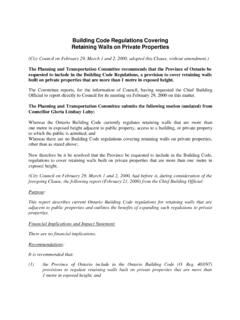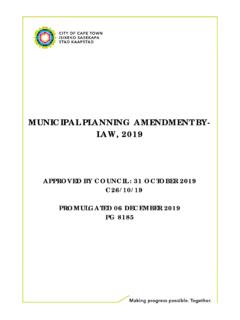Transcription of Townhouse and Stacked Townhouse Urban Design Guidelines
1 Townhouse AND LOW-RISE APARTMENT Guidelines . Townhouse AND LOW-RISE. APARTMENT Guidelines . Draft Oct 2015. T. AF. DR. DRAFT. Urban Design . Guidelines . 2015. Townhouse AND LOW-RISE APARTMENT Guidelines . T. City of Toronto AF. Townhouse and Low-rise Apartment Guidelines Core Team Harold Madi, Director of Urban Design Diana Birchall, Program Manager, Urban Design DR. Leo DeSorcy Maaja Eichfus-Clarke Emilia Floro Victor Gottwald Anthony Hommik Jack Krubnik Mladen Kukic Peggy Lee Joseph luk Deanne Mighton James Parakh Xue Pei Andrea Reaney Allison Reid Michael Sakalauskas Derrick Wong Townhouse and Low-rise Apartment Guidelines online: Table of Contents Townhouse AND LOW-RISE APARTMENT Guidelines . Introduction Background Evolution of the Townhouse in Toronto Definitions Zoning By-law 569-2013. Purpose of the Guidelines How and Where the Guidelines Apply Guilding Principles Quality of Life and Livability Design Excellence T.
2 Sustainable Design Heritage Conservation Organization of Guidelines AF. Site Context Context Analysis and planning for Larger Sites Public Realm Framework Street and Block Pattern Public Parks and Open Spaces Heritage DR. Site Organization Streets, Mews and Walkways Shared Outdoor Amenity Space Building Placement Building Address Site Servicing, Access and Parking Site Servicing, Access and Parking for Smaller Street-Related Townhouse Sites Building Design Fit and Transition in Scale Separation Distances, Stepbacks and Orientation Building Relationship to Grade and Street Building Entrance and Front Yard Private Outdoor Amenity Space Public Realm Townhouse AND LOW-RISE APARTMENT Guidelines . Streetscape, Landscape and Stormwater Management Streetscape Landscape Stormwater Management Site Elements Design Lighting Shared Facilities Building Elements Windows, Doors and Roofs Materials Public Art Bringing it all Together T.
3 Building Types and Configurations Townhouse AF. Stacked Townhouse Back to Back Townhouse Stacked and Back to Back Townhouse Apartment Building Hybrid Building Development Scenarios Shallow Mid-Block Parcel DR. Deep Mid-Block Parcel Parcel Adjacent to or with Heritage Resource Parcel with Multiple Building Blocks Large Parcel with Tower and Neighbourhood Edge Large Development with multiple Development Blocks Case Studies Glossary WNNHHOOUUSSEE AANNDD LLOOW. IINNTTRROODDUUCCTTIIOONN || TTOOW MEENNTT GGUUIIDDEELLIINNEESS. W--RRIISSEE AAPPAARRTTM. T. AF. Introduction Background Evolution of the Townhouse in Toronto Definitions Zoning By-law 569-2013. Purpose of the Guidelines DR. How and Where the Guidelines Apply Guiding Principles Quality of Life and Livability Design Excellence Sustainable Design Heritage Conservation Organization of Guidelines Credit: Quadrangle Architects Limited 5.
4 INTRODUCTION | Townhouse AND LOW-RISE APARTMENT Guidelines . Introduction To assist with the implementation of Official Plan policies BACKGROUND EVOLUTION OF THE Townhouse . and provide specific Design direction, the City of Toronto has IN TORONTO. developed city-wide " Townhouse and Low-rise Apartment The City of Toronto has a long, rich history of Townhouse or Guidelines ". The purpose of the Guidelines is to assist in row house development. Traditional Toronto townhouses achieving the appropriate Design of low-rise (primarily are generally 2 to 3 storeys high and are typically of a residential) buildings for a range of building types from Georgian, Victorian, Edwardian or Arts and Crafts character. townhouses, through to Stacked and back-to-back townhouses Townhouses of this nature have been a common and successful and low-rise apartment buildings up to 4 storeys in height.
5 The form of residential development since the mid-1800's. Guidelines will build upon and replace the "Infill Townhouse Guidelines " (2003) which have been in use by the City of In the post-war period, townhouses were developed in new lot Toronto for over 10 years. They will address infill Townhouse and block configurations of grade-related housing, promoted T. developments as well as developments on larger sites and the by the Canadian Mortgage and Housing Corporation (CMHC) as good for families. Typically these were laid out on large blocks more complex and intense types of low-rise, multi-unit housing near higher density forms of housing, schools and shopping in terms of: site context; site organization; building massing;. AF centres. They were often rental housing with the site remaining detailed Design , and the semi-private and public realms. in private ownership.
6 This type of Townhouse was organized around private streets or pedestrian mews. Vehicle parking was accommodated in small parking lots at the edges of the site or integral to the Townhouse with access gained from a private street. Over time, new types of housing units emerged within the DR. Townhouse form that introduced new relationships between the individual unit, vertical circulation and grade. In the early years of amalgamation, the City of Toronto introduced the Infill Townhouse Guidelines (2003) to help assess the large and growing volume of Townhouse development applications on small, infill sites. The infill Guidelines responded to, among other things, the decline in the quality of streetscapes by the erosion of areas for landscaping and street trees created by the market for narrow frontage towns with integral front parking and garages. The City's Official Plan, which was approved by Council in 2002, requires new developments to take their address and access from public streets.
7 To support this policy goal, Council adopted, in 2005, the Development Infrastructure Policy &. CITY OF TORONTO. Standards (DIPS). The DIPS standards place limits on the 2014 / 2015. creation and Design of private residential streets and establish clear directions for the layout and Design of new public Cabbage Town Townhouse residential streets. 6. INTRODUCTION | Townhouse AND LOW-RISE APARTMENT Guidelines . Example of low-rise buidlings in the form of garden apartments/courtyard walk-ups. Townhouses and low-rise buildings are common in many parts of the City. Since the adoption of these earlier standards, the demand for The Infill Townhouse Guidelines (2003), which speak to low-rise grade related housing has remained strong. Over Townhouse developments on public streets and short private T. the past ten years, land and construction prices have risen. mews, and the DIPS (2005) standards for new residential Increasingly, townhouses and low-rise multi-unit residential streets fail to cover some of the more pressing questions of buildings are now being constructed on large sites with organization and fit that arise in many of today's development underground parking garages.
8 These larger sites are often applications. The Guidelines in this document have been AF. found at the edges of "tower in the park" apartment areas and on lands being converted from employment and institutional developed to ensure that the wider range of planning considerations presented by the current forms of low-rise uses. As well, low-rise residential intensification continues to residential intensification are fully addressed. The objectives take place on smaller infill sites. There has evolved, along with of the Guidelines are to produce building designs and the conventional Townhouse , a variety of taller, denser and development layouts that reflect the broader land use planning more complex forms of multi-unit, low-rise housing. (see below goals of the Official Plan and which, in the process, create an for a description of types). attractive public realm and comfortable private living spaces of DR.
9 The highest achievable quality. Spruce Court Apartments (completed in the 1920s), is one of the earliest examples of publically supported, affordable, Low-Rise Multi Unit Housing in Toronto. The "Garden City" influence is prevalent through the use of large grassy, sunlit, courtyards and play areas which were accessible to all units. (Photo Credit: Spruce Court c1920, City of Toronto Archives, Fonds 1244, Item 43.). 7. INTRODUCTION | Townhouse AND LOW-RISE APARTMENT Guidelines . DEFINITIONS Apartment Neighbourhoods designations. They often fit T. under the four-storey height limit for residential development Low-rise, multi-unit residential buildings take many forms: in designated Neighbourhood areas but policies regarding Townhouses are generally 2 to 3 1/2-storey structures that neighbourhood fit may impose restrictions. It is important AF. share a sidewall with a neighbouring unit and have at least three housing bays.
10 They typically have a front and a back. Stacked Townhouses share a sidewall and have units Stacked vertically (typically two or three). Like the Townhouse type they have a front and a back. that the more intensive forms of low-rise, multi-unit residential development fit harmoniously within the existing neighbourhood context. (See Section 5 Bringing It All Together for more detail on the various types of low-rise, multi- unit residential buildings). Back to Back Townhouses share a rear wall as well as a sidewall and have two fronts. Each unit has its own entrance to Zoning By-law 569-2013. DR. grade. Townhouse and Low-rise Apartment buildings take many Stacked , Back to Back Townhouses share a rear wall as well forms, but can generally be understood as predominantly as a sidewall and have units Stacked vertically. This can include residential buildings, up to four storeys tall.












